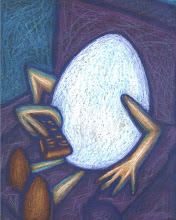Small Change
I've seen a lot more homeless people on the streets in the
past few years. This is an issue that really gets to me. I've been so close so
many times to being homeless myself that I stare at these people with fear and
compassion. I was guided to start a practice a few years ago when I quit smoking. I
now use the ash tray where my cigarette butts used to go for a change
compartment. When I see a homeless person I grab some change and hand it to
them. I'm not there to judge who deserves the change and who doesn't. That
takes too much time and negative energy. It doesn't really matter to my why they need the money. They're asking so I'm there to give.
I've met a lot of homeless people this way. I'm shocked at
who is homeless on the streets these days. One woman my age was sitting on the
side of a freeway one day and I gestured for her to walk up to my car. I handed
her a few dollars in change and noticed she had a black eye. She saw me look at
her face and replied, "I was robbed and beaten last night." I broke down crying
right on the spot. It's like a wave of pain rushed over me.
Another time I handled the situation a little better. This man with a dog
had made his 'camping' spot in a strip center near my home. I would see him
every day and give him my small change. One day I saw him crying. I'm used to
seeing homeless people cry. In fact, they seem a little hardened by life so I had to find out what happened.
I went home and made him two peanut butter sandwiches (one for him and one
for his dog) and grabbed a ten dollar bill out of my purse before rushing out
the door. When I walked over to him he wasn't crying any more instead he looked
angry. I handed him one sandwich and put one on the ground for his dog. He
replied "She won't eat it. She's real picky." He was right. The dog
sniffed the sandwich and walked away.
I handed him the $10 bill and his face perked up right away.
He then grabbed the other sandwich and began eating it. I wanted to ask him why
he had been crying but I didn't have to ask. He spoke up and said, "Do you
know what someone said to me?" I listened. "They told me that it was
cruel to keep my dog on the streets with me. They said I should give her
up!" I looked at the dog that was walking around freely with a leash
dragging behind her and stated the obvious. "Well, if she wanted to run
away, she would. I don't think you're cruel at all." He was grateful that
I validated him and he then affirmed, "She eats before I do! I make sure she has
food every day."
I talked to him for a little while and then went home
thinking about how judgmentally cruel some people can be when they don't have all the facts. This guy was having a
tough time on the street and someone suggested he give up his only companion?
It was hard to believe. I kept giving him money every time I saw him.
A few weeks passed and I saw him outside on a summer day. He told me that
someone had offered him a job digging ditches in the "hot sun." He acted like the offer was ridiculous. I
looked at him and stated the obvious, "Aren't you in the hot sun
anyway?" I don't think he even realized this before my comment. I didn't see him again after
that.
I think he took the job.











